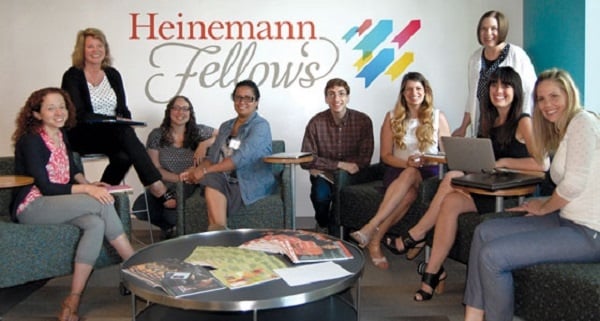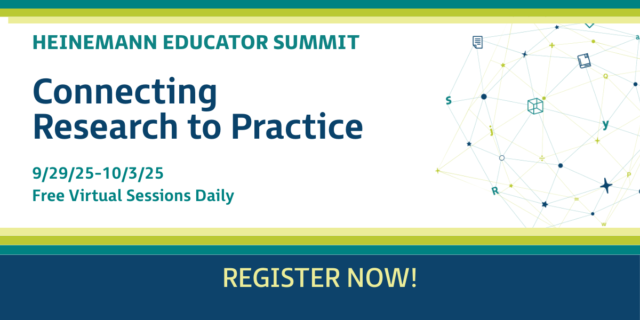
Lisa Birno is a Heinemann Fellow with the 2014–2016 class, and has been an educator for 27 years.
“She outlawed getting in trouble...”
By Lisa Birno
I’ve turned those words over and over in my head for months now. One of my sixth graders used them to describe me at the end of our year together last June. Those words touched me, but they also haunted me.
Yonis was new to our school. He was polite, savvy, intelligent. On the first day of school we talked about how our class would work. He was the one who asked, “What happens when you do something wrong?” It took me aback. We’d been sharing our hopes. But he’d hit a nerve. His classmates were eager to hear the response.
“We fix it,” I said. I can’t claim any huge insight behind my response; it was just logical. I knew I didn’t want to establish some kind of reward and consequence system. And I’d promised them a safe place.
That exchange stuck with me because it framed how we’d function as a learning community. In effect, he was asking if I was judge and jury. I didn’t realize it was the first step in two important parallel paths: one with my students and another with my Heinemann Fellows colleagues.
—
In effect, he was asking if I was judge and jury.
—
My work as a Heinemann Fellow over the past 18 months has challenged me, exhilarated me, exhausted me. I’ve examined my practice as never before. That can be incredibly rewarding and incredibly uncomfortable. It has reminded me of my role as a learner. It is not the kind of comfortable learning where you’ll say to yourself, “Oh, I’ll learn more about that because this book looks good.” Rather, it’s the kind of learning that takes you straight into the learning pit, the one that forces you to wrestle with yourself. It’s a learning of struggle, the kind that doesn’t always feel safe.
James Nottingham describes how challenge leads to more powerful learning in his description of the learning pit (Nottingham, James. “The Learning Pit.”). Specifically, he explains that we need to wrestle with confusion—to actually face cognitive conflict—in order to come to a deep understanding. It can be a powerful experience for our students, but how willing are we to face it? How willing was I?
At the heart of a workshop model, students experience authentic work. They act as mathematicians in math, scientists in science, writers in the writing workshop. But what does it mean to act as a learner? Do teachers engage in that work?
Pursuing my action research project with the Heinemann Fellows required that I learn to trust my colleagues, make my thinking visible to the group, discuss my challenges, share my results, and ask for feedback. My work would become more public, reporting out to everyone in our project and sharing our work through blog posts. It was intimidating, and then I realized it mirrored what I expected my sixth graders to do routinely: pursue inquiry, work with their peers, build ideas through purposeful discussion, and share work with a larger audience.
—
There lies the richness of the work.
—
Yonis pushed me on day one to frame the way our class would function, and while the notion of our classroom as a learning community was important to me, I hadn’t considered that my time as a Heinemann Fellow would become an opportunity to experience a learning community from the students’ perspective.
Six months into our Heinemann project, we met to share the data we had gathered. We discussed the notion that it wasn't too late to change things. Six months in and still thinking about what we needed to change, shift, tweak, adjust—a long time to wrestle with something, but there lies the richness of the work.
I thought I’d laid out my project well. I’d included multiple data sources: standardized, anecdotal, interviews, and student responses. When I shared pieces with my research group, however, they stopped me. They told me I’d overlooked a rich source of data—my students’ reading response letters. It never occurred to me that this might reflect how incorporating purposeful talk into our class impacted them. Their letters showed growth across the class and I’d overlooked the connection. In spite of the fact I’d overlooked something, it was exciting. My colleagues helped me add a rich piece to my project. How could I capture that same feeling for my students?
The key in both worlds is the absence of fear. Supportive and encouraging learning communities are safe. That safety allows us to reach out for help or admit confusion. Without judgment, we can focus on the learning.
I brought this idea back to my sixth graders and they embraced it. We taught each other what a safe sixth grade learning community could look like. We had honest conversations, shared our confusions, and sought help when we couldn’t find our way. It challenged my sixth graders but they owned the problems and worked through to solutions.
Each step connected to my work with the Heinemann Fellows. My colleagues helped me see what it’s like to wrestle—really wrestle—with a concept and become the kind of learner who strives to understand big ideas. They helped me see the power of a truly supportive learning community.
I didn’t outlaw getting in trouble for my sixth graders. Simply, I helped them form a powerful learning community, one concentrated on wrestling with meaningful work and fixing things when they go wrong. My students taught me that it should be the heart of every classroom.
♦ ♦ ♦ ♦
*The views expressed above are Lisa Birno's alone and do not necessarily reflect the views of the Eden Prairie Schools.
Heinemann Publishing is seeking applicants to become part of our newest class of Heinemann Fellows, a small group of educators who exhibit exceptional promise for concentrated, enhanced pedagogy.
Click here to learn more and apply.

Lisa Birno is a sixth grade teacher at Forest Hill Elementary School in the Eden Prairie Public School system of Minnesota. Her action research question as a Heinemann Fellow is, "What instructional strategies are most effective in promoting equitable and engaged talk in a Midwestern, suburban sixth grade self-contained classroom?"
Follow Lisa's progress on Twitter @LisaBirno


